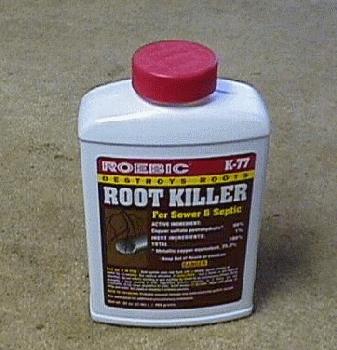Turn Natural Gourds
Into Martin Homes for
Purple Martins

If you plan to use
natural gourds as your choice of housing for your martins, then on this page,
we'll describe what's required to turn natural gourds into housing for
Purple Martins. Gourds can be used to house other cavity nesting birds also as
well, and the same general criteria will apply. Just use the proper size gourds and
entrance holes for that species along with the proper location.
It's common
knowledge that martins love a good large natural gourd to nest in. It
might be the feel or the looks, but what ever it is, in some areas of the
country, they flock to them.
If gourds are going to be your preferred housing, then the following are a few
tips to make them into martin houses.
The following
tools or items will be required to complete the project:
Obviously, you'll
need some gourds. Make sure they're nice and big, at least 9 or 10 inches
in diameter and as thick walled as you can get. The thicker the wall, the
better. General shape and looks are your own preference. The
martins don't care about their shape but some people like to use particular
shapes.
You'll need a jigsaw with a scroll cutting blade. This will allow you to cut the round curves of the holes.
A 2" hole saw
(if you plan to use 2" holes in your gourd).
A drill with a
1/4" and 3/8" bits, for drilling the hanging and drain holes.
A wood rasp with
one side rounded.
A plastic entrance
port with a screw on lid that is at least 100 millimeters in diameter...
(Approximately 4"). You need to be able to get your closed fist
through the opening. (See details below).
An entrance port
with 2 porches. (Again, see details below).
Some Copper
Sulfate. Used to preserve your gourds
A large container
large enough to hold at least 5 gallons of water.
A pot scrubber of
some sort. The stainless metal ones seem to work the best.
A black marking
pen of some sort or a pencil
A paint brush.
A tube of LEXEL
caulking and a caulking gun. LEXEL can be purchased at just about any hardware store
Some good 'white'
latex primer and house paint.
A respiratory mask
for those that might have breathing problems.
Two things:
IF... your area is starling free and you plan to use 2" round holes, then the entrances shown below will not be required.
However; if starlings are in your area, then you WILL need them, so before you can make your gourds into martin houses, you'll need to order the entrance assemblies and access ports. S&K Mfg has some wonderful little plastic parts that work wonders in turning a gourd into a martin house and you will need to order these BEFORE you begin actually working the gourds. Simply call them (1-800-764-8688) and tell them you need X amount of gourd entrance assemblies and access ports for gourds. There are a number of different SREH options, so you might want to read up on them and decide which style you want to use. They'll have them in a box and shipped off to you in no time. As you'll see further down this page, they are very easy to use and the entrance holes are very accurate. No messing with measuring anything.
Note: Since the writing of this page, they've made some minor design changes to their entrances and they will come with a flat plate molded onto them (for mounting onto their manufactured gourds). This DOES NOT change any of the instructions below for mounting them. IF you don't like the plate, it can simply be cut off with a band saw or jig saw. Just make sure you order BOTH the entrances and the access ports. The access ports come separately.
The porches will have extensions on the, so AFTER adding them to the port, the INSIDE extensions should be broken off so they will go into the entrance hole in the gourd. There are small snap lines molded into the porch extensions, so simply snap them off with your fingers.
They also come with
'snap in plugs' so simply plug the hole you're not going to use.
Another way of
contacting them is thru their web page. S&K
Manufacturing

Also, another version of an entrance hole assembly that can be used like this can be found here. Entrances By Sandy
All you have to do is adjust the hole you cut in the gourd to accommodate it.
Sandy makes good quality stuff and stands behind his products.
OK, on to
making martin houses from gourds.
Once the gourd is finally dry, (and some can take months to fully cure), it will require cleaning. The outside skin will have all the residue on it that remained during the curing process. This will range anywhere from just a light coating to something that looks like the one shown below. Even though the gourd has a lot of this residue on its outer skin, there is nothing wrong with it. It simply needs to be cleaned off.
NOTE: The curing of gourds CAN NOT be hurried. It is a long, time-consuming NATURAL process, so please don't try and rush it. It just isn't going to happen.
And, REGARDLESS of what you've may have heard on other
sites, NEVER... cut into a 'green' gourd. That will only ruin the
gourd. It should be hard and sound brittle when tapped with a tool, such
as a pocket knife.
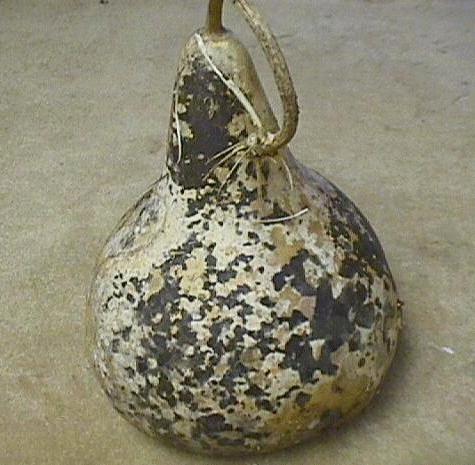
The first thing to do is to cut the stem. (I leave mine long when harvesting, simply because its easier to handle them).
If not already cut in the field at
harvest, using a pair of pruning shears, (or sharp utility knife), 'cut' the stem.
Length is not an issue. The closer to the gourd, the better for finishing
and hanging. Never "twist" off a stem. They are very
stringy and it really doesn't look all that great.
Now for the
cleaning! This can be done in a number of different ways.
Respiratory
Note:
IF you plan on dry
sanding them, the dust from
gourds is very acidic and does have an effect on folks that have respiratory
problems. If you are one of these folks, it is advisable to wear a
respiratory mask so that you don't breathe in these dust particles or use an
alternative method to dry sanding as described below.
If you only have a very few gourds to do, (say 3 or 4), one method of cleaning the residue off is to sand if off. Now, I'll say this up front. I don't like this method because if you are new to this and don't know a lot about sanding gourds, there is a very good chance of sanding thru the outer hard shell, and that is something you do not want to do. The outer skin of a gourd should NEVER be broken.
However, here's how it's done anyway.
Using about a 100
grit sandpaper (or finer), you could simply put the sandpaper over a small block of
Styrofoam. It works very well. Styrofoam is very soft and will
conform to fit the curves of the gourds better.
A second way to
clean gourds is a whole lot easier than sanding. It might be a little
messier, but the results are much better. Purchase a little metal
scrubber (plastic will work, too) and then get a bucket of water. Just about everyone
has old 5 gallon buckets laying around and they will work just great for this
project if you only have a few gourds to do. However, if you have more,
then a little larger container will work better because it's nice to have a
little extra room to work. I got these scrubbers and a large container from
Wal-Mart, but they can be found just about anywhere. These
can also be purchased in just about any grocery store in the kitchen aisle and
they do a wonderful job. Submerge the gourd in the water for about 15
minutes, (held under the water by something heavy) then simply begin scrubbing.
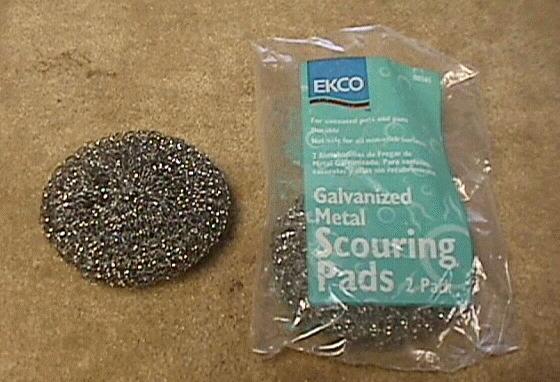
Another tip here, let the 'dirty' gourds sit outside for a while under a water sprinkler of some sort. A soft rain on them for an hour or two works wonders to soften that outer crud.
NO, this will not soften the original gourd in any way.
The water softens the residue on the outside of the gourds and it easily scrubs
off with the pad. These pads work great at removing the debris and
there's no gourd dust flying all over the place for those having respiration
problems. Simply set the gourd in the pan or bucket of warm water and
start scrubbing away, turning the gourd as you go. If you have a bunch to
do, then you might also want to purchase a pair of thick rubber gloves to save
on the hands. Clean it as much as you like, then set it aside to dry or
simply towel it dry with a paper towel. Don't try and remove every
spot. Some of them are discolorations in the skin and they won't come out
and besides, you're going to paint the gourd anyway, so they don't have to be
perfect.
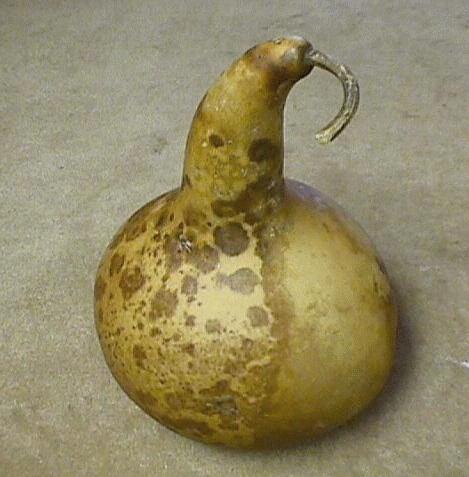
However, a third
method I've found to be even easier is to use a pressure washer and PRESSURE
WASH the dirt and debris off. Yes, this works wonderfully and if you
have a lot of them to do, then you might want to consider this method. No
dust to worry about here. No tired arms or sore hands either. Many
folks have these little home pressure washers around now a days and this method
works great. I made a small, but heavy stand with two sides and a back
out of welded screen making a little open cage so to speak. If you want
to make one, it's 18" wide x 20" deep x 13" high. The wire
mesh can be anything you have around as long as the holes are big enough to let
the debris through. (Chicken wire works just fine). Although it doesn't show very well here, I lifted the
front up 1" before I screwed the two front legs on. This allows the
gourds to always roll towards the back of the jig. Again, let the gourds
sit for an hour or two under a water sprinkler to soften the debris on the
outsides. Then simply place the gourd in the stand and spray away.
The gourd often turns around by itself as the spray hits it and there is seldom
any extra handling.
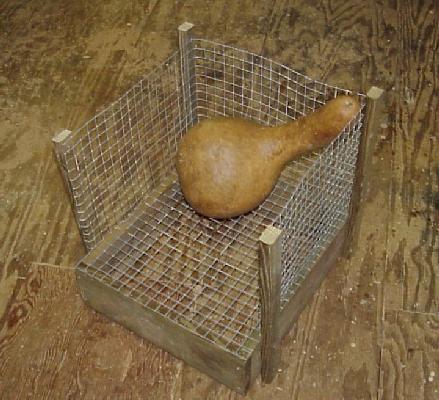
One more
caution here. You might want to wear some safety glasses and a good
rubber apron or rain coat. Yes, it can be wet with the occasional spray bounce
back, but it's so easy that it makes it all worth the while and if you're
careful, it really isn't that bad. Plus, if you do it on a warm sunny
day, it isn't bad at all and is actually kind of fun.
This is also a
good way to tell if you have quality gourds with good thick walls. If you
have gourds that are thin walled, this pressure washing method will sometimes
cave them in and THIS IS GOOD, because if a gourd can't take the force
of the washing, then the quality of the gourd wasn't good enough to be a martin gourd in
the first place. I wash a lot of them and this has obviously become my preferred
method. The gourd shown above was washed using this method and so was the
one shown in the jig, so you can see the results you get.
The next step in
the process is to cut the access port hole.
One note here:
Since the
introduction of the European Starling into this country, the purple martin has
suffered greatly from these fierce nesting competitors and with the advancement
of the starling into just about all of the martin's range, starling resistant
entrance holes of some sort are a must at any martin site. No, starlings
are not a problem everywhere and I've heard stories from folks that they've
never seen a starling at their martin site. (I say they're lucky and that
it's just a matter of time). However, for the majority of
the country, this is not so. Starlings have become a very big problem and
if this is the case at your site, then I highly recommend that SREH's be
used. Starlings must be kept out of martin housing at all costs.
For a number of reasons, if starlings are present, then round holes are no
longer advisable and many of the responsible housing and plastic gourd
manufacturers are changing all their tooling over to them. And best of all, the
martins don't even hesitate in using them once they get used to them. My
entire site has been changed over to crescents and trust me, I stopped having
starling problems from the very day I made the change from round to crescent.
The following
is the procedure for adding your entrances and ports into your gourds.
Select your gourd
and look at it. The first thing you need to do is decide where you want
your entrance hole. Simply mark and X on that spot. Then, 90 degrees to the right of it, (or left, if you're left
handed and want to use that side) and up high on the side of the gourd, (as
shown below) lay the
access port on the side of the gourd and draw an outline around it on the gourd.
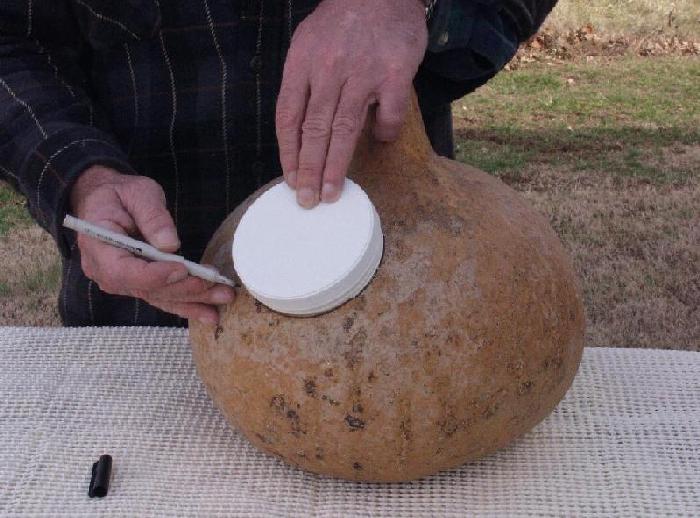
Next, using a
drill, drill a 3/8" hole near the bottom line of the rings. This is
used to put your jigsaw blade thru to cut the ring out.

Next, using the
jigsaw carefully cut out the access port hole, cutting just inside the
line. It can be fine tuned to the
exact size later.
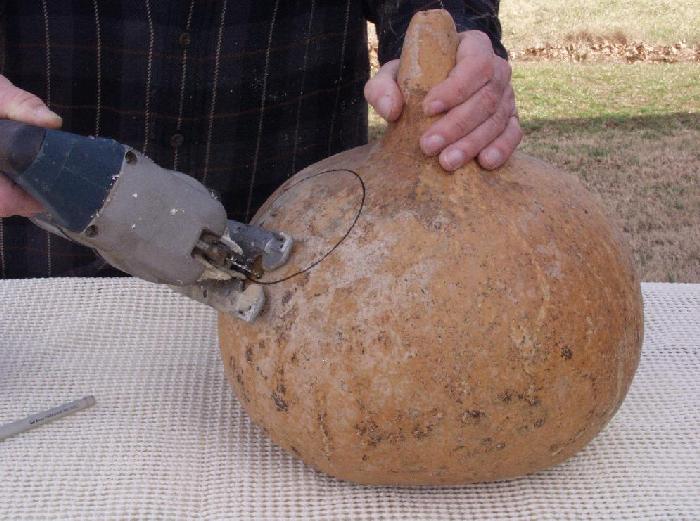
This is a good
time to check gourd thickness and make sure it's a good gourd to use for
martins. If poor quality and thin walled, it is suggested it not be
used. However, if that's all you have, then...
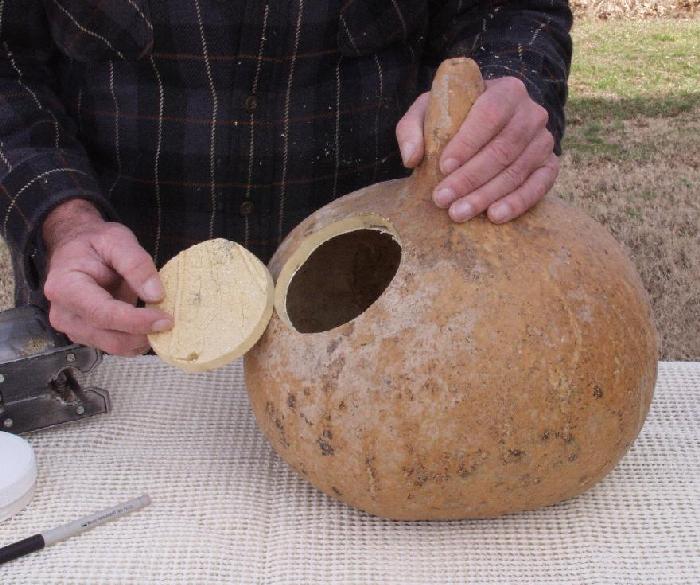
Next, we want to
establish the equator of the bulb part of the gourd. To do this, hold the
gourd by the neck with two fingers, approximately where the wire will be placed
and let it swing freely. (Or if you like, you could actually drill the
hanging hole and add the wire now). This will let the gourd find its natural CG
(Center of Gravity). Now, at the 'equator' of the bulb and where the
entrance is going to be placed, carefully draw a level line at this point in
the center of where the entrance hole is going to be placed. This will be
the centerline of the entrance port.
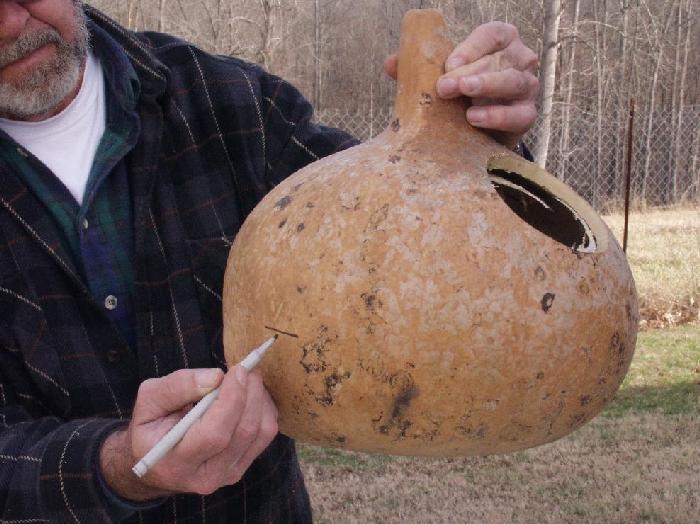
Again, hold the port tube up to the gourd and center it over this line. Then, as before, outline it with the marker.
Tip: If you
have a gourd that's on the lighter side, slide the port up about 1/2"
before drawing the outline. The reason for this is, the weight of the port
will make the gourd want to tip a little forward and the half inch compensates
for that.

And as before,
drill and carefully cut out the entrance hole.

Now you need to
get the seeds and everything else out of the gourd. No need to scrape it
clean, just what ever you can get out with your hands. Any loose flaps of
dried membrane should also be removed. The 4" holes
make this very easy to do.
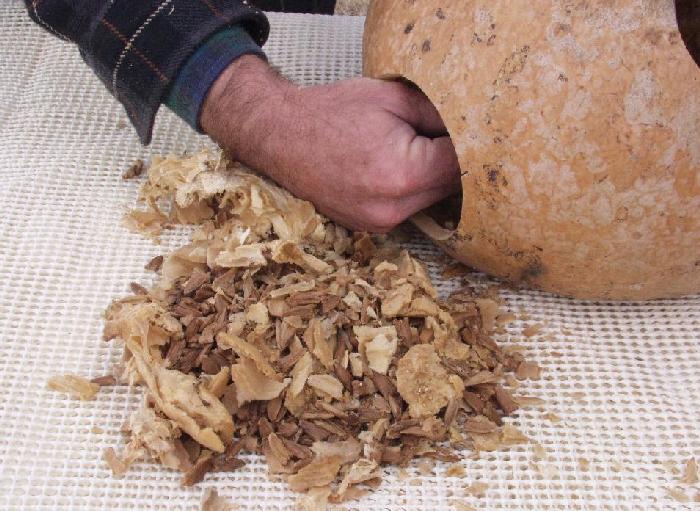
If you have a good
thick walled gourd or you plan to grow some, then these gourd seeds should be
saved in a good airtight container in a cool place so they can be kept dry and safe from
Varmints. (Mice love these things).
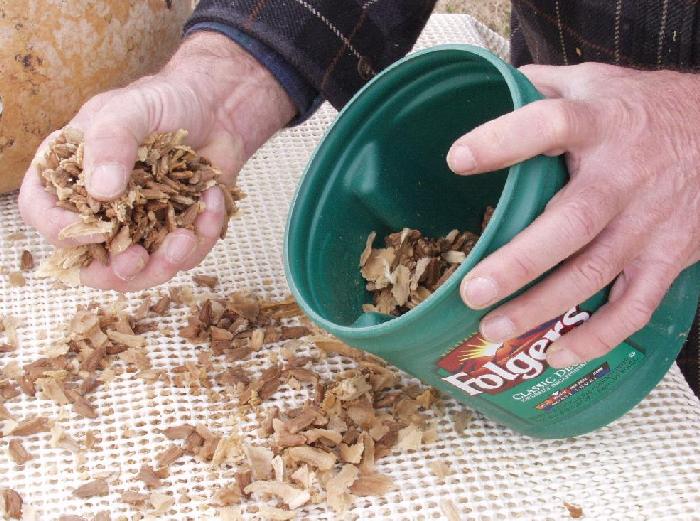
Take time to soak
them in Copper Sulfate.
If you plan to
soak your gourds in Copper Sulfate, (see bottom of page how to obtain Copper
Sulfate) then now is the time to do that. Copper Sulfate is not a
preservative, but instead is a fungicide and will kill all the bacteria and
fungi that instigate the rotting process of a gourd. Soaking a gourd in this
mixture for about 30 minutes. Simply mix your
Copper Sulfate, 1 pound to 5 gal of water in a container large enough to hold a
couple of gourds. I do a lot of them, so I use a large plastic
garbage can and do them 3 at a time. Stir it up good and then submerge the gourds under the water
for at least 30 minutes. I use a stick stuck in one of the holes and push
it down into the mixture. A weight tied to the other end of the stick
holds the gourd under the water. This one action makes them last much
longer than if they were not soaked at all and considering all the work that
has to go into making them, it’s worth every minute.
After soaking for at least 30 minutes, drain and then set your gourd aside for a day to fully dry. It will have a slight greenish tint to it from the sulfate, but don't worry, it will be all covered up by paint anyway. And no, you don't have to worry about the green inside, the martins don't mind at all. DO NOT rinse them out to get rid of any excess sulfate from the inside. This would be defeating the purpose of soaking them in the first place.
No, Copper
Sulfate is not harmful to the birds.
ANOTHER NOTE:
Don't just dump
your Copper Sulfate out when you're done. It will kill plants, and in
fact, is used for that purpose in septic systems. If you're on city sewer
systems, then it can be discarded that way. But if you're out in the
country, make sure that where you dispose of it will not harm any plants or get
in any water systems. I actually leave the top off my garbage can and
cover it with a screen so nothing can get into it and let the water
evaporate. The Copper Sulfate simply re-crystallizes for use at a
later time simply by adding water. Think Safety.
Now, with that
said, we can start adding things to the gourd. First the port ring can be
positioned in the hole you cut for it. If it doesn't fit nice and snug,
or fit at all, then use your rasp and carefully work the gourd hole bigger
until it does. By adding the cover to the ring, it keeps the ring nice and
round and also helps with the insertion depth. Insert just a portion of the ring into the gourd, you
don't want to go too deep or there won't be any room to caulk. (I show
mine cover off for photo purposes only). I like to cut my holes a little on the small
side on purpose and then carefully rasp the holes out so that my parts fit nice
and snug. Don't force them! They need to be snug, but you don't
want them so tight that they will be deformed when inserted.

Note: I assemble the parts to my entrances BEFORE I try to install them into the gourd. It gives me a much better idea of how the porches set when the gourd is hung by the neck. Note how the one shown is assembled. Porches should be flush (level) with the crescent bottoms. This alone will frustrate any long legged starling to no end. They just can't get down to the hole like a short-legged martin can.
And why the inside porches, you
ask? Because, unlike houses, gourd
entrances are up on the side wall of the gourd and this makes it difficult for
the martins to exit these types of entrances. The internal porches on these assemblies make it much easier
for a martin to exit the gourd. I
always add a little bedding (wheat or pine straw) in the gourds before hanging
them and the martins really appreciate it. I add enough so that it is level
with the inside
porch. The martins will use this as a base for their nest, usually adding
what they want on top of it to suit their desires.
Entrance Hole
Assembly procedure:
The outside of the entrance is the concave side.
Add the porch with
2 push pins to that side first, the top of the porch level with the bottom of
the Crescent.
Now add the inner porch over the push pins, the top being level with the bottom of the crescent. Squeeze the push pins to make a good and snug assembly. Snap off the two porch extensions from the INSIDE porch.
Now the same
procedure that was used to put the port hole in can be done for the entrance
hole assembly. Fit this assembly to the entrance hole and if needed, rasp
the hole to size. Once it fits the way you want it, hang the gourd with
your two fingers as before where the hanging hole would be (or the wire if you
already added it) and make sure the
porches are setting level. If not, adjust the entrance assembly so that
they are. This might mean pulling
the bottom out a little because gourds are not flat. A couple of things here: Don't push the entrance
assembly all the way into the gourd. Leave the rim sticking out about
1/4". This will allow for caulking. And don't worry if it
isn't fitting the gourd perfect, they will be caulked closed anyway and all
gaps will be closed up.
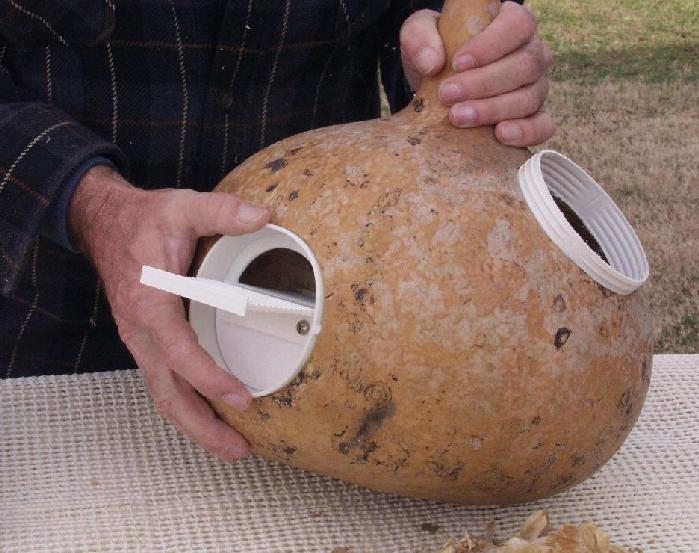
Now, if you haven't
already, drill
the hanging hole. Looking at the gourd, drill it 90 degrees
to the entrance as shown, or if you like, parallel (front to back) with the
entrance hole… and regardless of what you may have heard, it really doesn't
matter. I like mine to go from side to side, but some folks have
systems that require them to be front to back. It's your own preference
or requirement. Plus, I like my
gourds to swing freely so I use plenty of good 12 gage plastic coated
electrical wire.
And while you’re
at it, drill at least 3 or 4, 1/4" holes around the underside of the gourd
for drain holes. This will allow any water that does manage to get in to
drain out and keep the nest dry. YES, these drain holes ARE
REQUIRED.

Before doing
this part, see note below at the bottom of the page:
Now, using the caulking gun and
Lexel,
carefully caulk around the edges of the access port and the entrance assembly
as shown. Go slow and take your time. This stuff can be messy, but
if done carefully, very little clean up is needed. Also, a wet soapy
finger will help work this stuff without your getting it all over.
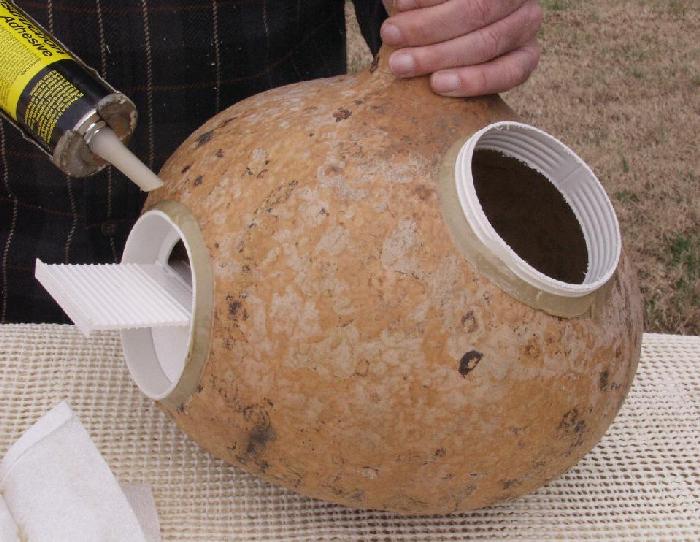
A paper towel
comes in handy to clean up any spots that are not wanted.
Also, this is a
good time to hang the gourd by the hanging wire and see if your gourd hangs nice and level.

And finally, one
very nice martin gourd, ready to let set and dry for about a day or two.
Don't rush. That only makes for a poor quality job. Let time do its
thing in drying and curing things.

A Note Here:
I show and used PPCA as a caulk to make this gourd. Yes, it does work very well... initially.
HOWEVER, I found
that, over time, it hardens and becomes very stiff and brittle. After checking on a few of the gourds that I used it on, I’m
finding that, because of the swelling and shrinking of the gourds due to heat
and cold, minor cracks are showing up between the gourds and the
PPCA and this will let rain into the gourd. I feel that after time, this product, because of its
brittleness, could crack and separate from the gourd and form major cracks.
In all my previously made
gourds, I used a material called LEXEL.
I have found that this material is much better suited for an application
like this and plus, it NEVER hardens and it sticks to the Polyethylene parts extremely well. Gourds that I
prepared many years ago are still going very strong without a single failure or
crack. I would suggest that if you
fear that using PPCA might be a problem for you, then use the Lexel. It can be obtained from
many hardware outlets.
Finishing:
Now once the caulking is fully dry,
a heavy coat of a good exterior wood primer can be added.
Again, let this dry fully. It needs to dry on the gourd so the paint will
stick to it later. And finally, 2 coats of a good exterior white paint
should be added to the gourd, with plenty of drying time in between
coats. Once dry, these gourds will make wonderful houses for purple
martins and if done correctly and taken care of in the off-season, these gourds
will last for many years.
As you'll no doubt
notice, I didn't add any form of canopy. Not needed! My reasons...
...the entrance is
already set back into the gourd...
...the entrance
edge is stuck out from the gourd by about 1/4" - 3/8" so any dripping
dew or light rain will bypass the entrance.
...the martins can
now come out of their gourds and look skyward for any impending danger without
being hindered by a canopy. I feel that martins need to look up to spot
any impending danger such as hawks and I feel canopies hinder this and in fact,
I've removed them from any gourds that I have just for that reason alone.
A lot of work,
maybe! But then this is supposed to be a hobby and is something that can
be enjoyed all year long. There's no reason to only enjoy the martins
when they are here. Working on their housing while they are gone helps
keep the interest in the hobby and building our anticipation of their return
and of course, that's what it's all about. Plus, working on them in the
off-season doesn't require you to rush. You can take your time and do a good
quality job. It accomplishes
nothing to rush and get the gourds done in Feb if the martins aren’t going to
arrive until April. And in the spring, when you first pull that rack up
with all these beautiful white gourds, the martins will have a hard time
resisting at least investigating them. And I promise, when the martins do
return, they'll thank you by filling your hard worked gourds with lots of
babies for you to enjoy for many years to come. And if you take them
down and clean them out every year and place them some place dry for the
winter, (and away from any critters such as chewing mice) they'll last you for
15 or 20 years if you start with good thick walled gourds. I put mine in
large plastic garbage bags and hang them from the rafters of my shop.
Every couple of 5 years, I give them a new coat of paint and they look just
like new all over again. And, since the hard work is already done, I
simply bring out my little air compressor and spray paint the
gourds. It takes me about 1 minute per gourd and I actually hang them on
the racks to dry.
Oh, and one
last thing about SREH entrance holes...
If you've never
used SREH entrance holes before, when your martins see these type holes for the
first time, they may seem perplexed at them and apparently have problems
negotiating them... DO NOT WORRY. Because they feel pressure
on both their breasts and backs, they are tentative at first, but martins are
very fast learners and if your hole dimensions are correct, (which they are
right from the factory in this case) they will quickly learn to slip in and out
of these holes just as if they had been doing it all their lives, and in fact,
some of mine have. They've never seen any other type of hole. This
fear of a landlord seeing them apparently not being able to get into these type
holes is known as SREH ANXIETY. Give them some time to figure them
out and they'll do just fine. If you have a good location and good housing and they want in, then I promise, they will get in. And I also
promise, once you see that a starling is not able to negotiate these holes and
your martins can, you'll never regret making the change.
EXTRAS:
The following are
a few pictures of items I use just in case they might help you out.
Copper Sulfate
|
|
|
Copper Sulfate is easily gotten. Just go to your local Wal-Mart or K-mart plumbing section and get a product called ROEBIC root killer. As you can see, it's 99% copper sulfate and one can is usually enough to work 16 to 20 gourds with some to spare.
Other versions are
available, depending on where you shop, and they will work equally as well.
Paint:
You can use whatever primer and paint you desire. Latex is by far the easiest to work with.
I hope that the information here helps you in the creation of your martin housing and once they come, please take care of them.
